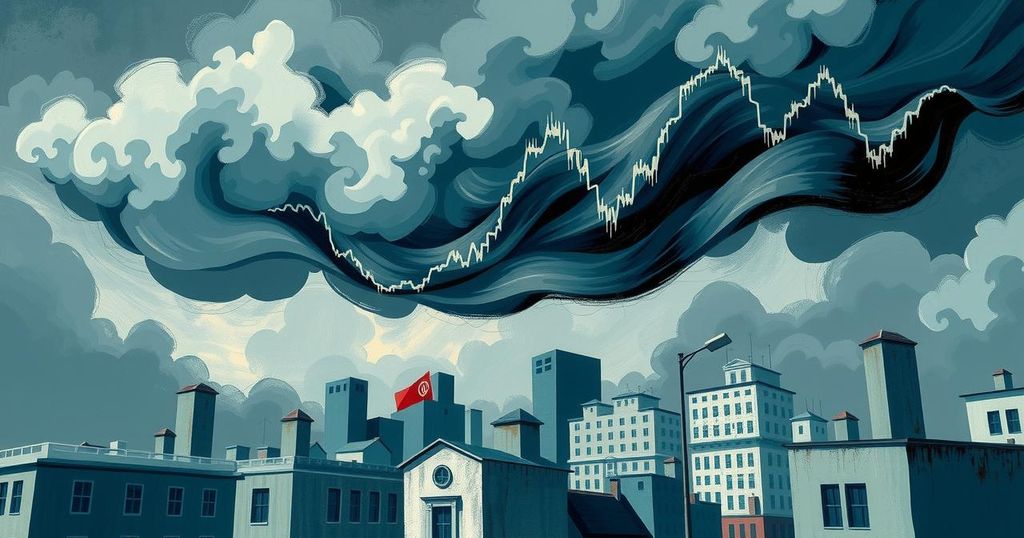Over 20 publicly traded companies in Brazil are currently pursuing bankruptcy protection, a trend expected to rise in 2025 due to high interest rates and mounting debt. Significant cases involve Bombril, Oi, and Americanas, while the market is witnessing increasing distress among companies. Experts predict a heightened wave of filings in the coming years, alongside potential consolidation in the market as stronger firms seek acquisitions.
In Brazil, over 20 publicly traded companies are currently seeking bankruptcy protection or pursuing out-of-court restructuring, a trend projected to intensify in 2025 amidst high interest rates and increasing debt difficulties. Experts predict that corporate financial distress will reach new highs, with significant cases emerging, such as Bombril and Agrogalaxy, alongside ongoing processes involving telecom group Oi and retailer Americanas, the latter revealing a substantial accounting fraud.
Public companies face heightened scrutiny during these proceedings due to their large debt burdens and regulatory obligations for financial disclosures. This transparency not only highlights the struggles of larger firms but also sheds light on the precarious financial conditions facing smaller businesses. An analysis by Valor Data revealed that the average leverage among 52 companies in the Ibovespa index increased from 1.47 to 1.64 times, underlining the growing financial strain.
Fabiana Solano, a partner at Felsberg Advogados, noted that the financial landscape is challenging for both large and small companies. “Persistently high interest rates and global instability are having an immediate impact on businesses,” she remarked, indicating a moment of caution for publicly listed firms with considerable debt.
Companies such as OSX, which is controlled by Eike Batista and has filed for bankruptcy protection twice, and energy firm Light, currently restructuring, exemplify the growing distress. Furthermore, Teka, a textile manufacturer, has faced bankruptcy for over a decade, recently confirming its liquidation order.
The number of bankruptcy filings might be higher if not for some companies successfully restructuring their debts, such as airline Azul and e-commerce provider Infracommerce. Additionally, Aeris and Viveo are actively negotiating with creditors to avert more severe measures.
Despite having greater access to credit, listed firms are facing a frozen equity market due to investor reluctance and capital outflows. The only anticipated stock offering is from Caixa Seguridade, driven solely by compliance with liquidity requirements.
Current regulations stipulate that publicly traded companies under bankruptcy protection cannot be included in B3’s theoretical indexes, although their shares may still be traded. Roberto Zarour from Lefosse Advogados noted the significant challenges listed companies face in balancing transparency with the need for confidentiality during sensitive negotiations.
The recent surge in bankruptcy cases reflects a broader crisis underscoring that no company is immune to current economic turbulence. With many firms having accumulated debt, Laura Bumachar predicts that 2026 may witness even greater distress and filings.
Consequently, market concentration is likely to increase as stronger companies seek mergers and acquisitions amid the fallout from financially weaker firms. Distressed M&A activity is already on the rise, highlighting the urgency of the situation.
Light announced its restructuring success, indicating strong creditor support, while Azul outlined improved cash flows due to creditor negotiations. Other firms, such as Aeris, emphasized transparency in ongoing negotiations, and Teka ensured job protection amidst its liquidation process, striving for business continuity despite shareholder opposition to the loss of equity.
Overall, the prevailing economic issues suggest that Brazilian companies will continue to face significant challenges, necessitating adaptive strategies to navigate the uncertain landscape while working towards financial stability and operational continuity.
The current financial climate in Brazil is marked by an alarming increase in bankruptcy protection filings among publicly traded companies. With a predicted rise in corporate distress driven by high interest rates, firms are forced to navigate complex restructuring processes. Transparency regulations reveal the extent of the crisis, affecting both large and small companies. As market concentration grows due to the fallout from weaker entities, stronger firms may capitalize on distress through mergers and acquisitions, indicating evolving strategies in response to financial challenges.
Original Source: valorinternational.globo.com




